
Dhammayuttika Nikāya, or Dhammayut Order, is an order of Theravada Buddhist bhikkhus (monks) in Thailand, Cambodia, and Burma, with significant branches in the Western world. Its name is derived from Pali dhamma + yutti + ka (group). The order began in Thailand as a reform movement led by a prince who would later become King Mongkut of Siam, before also spreading to Cambodia and Burma. The movement became formally recognized as its own monastic order by the Thai government in 1902, with any Thai Theravada bhikkhus not within the order being referred to as part of the Maha Nikaya order. The Dhammayuttika Nikaya plays a significant political role in Thailand. The order has historically been favored by the Thai government and monarchy, with the order holding the majority of all royal monastic titles in Thailand and most of the Supreme Patriarchs since its founding having come from the Dhammayuttika Nikaya, despite the order making up less than ten percent of all bhikkhus in Thailand.

Buddhism in Thailand is largely of the Theravada school, which is followed by roughly 93.4 percent of the population. Thailand has the second largest Buddhist population in the world, after China, with approximately 64 million Buddhists. Buddhism in Thailand has also become integrated with folk religion (Bon), Hinduism from millennia of Indian influence, and Chinese religions from the large Thai Chinese population. Buddhist temples in Thailand are characterized by tall golden stupas, and the Buddhist architecture of Thailand is similar to that in other Southeast Asian countries, particularly Cambodia and Laos, with which Thailand shares cultural and historical heritages. Thai Buddhism also shares many similarities with Sri Lankan Buddhism. Thailand, Cambodia, Myanmar, Sri Lanka and Laos are countries with Theravada Buddhist majorities.
The Dhammakaya tradition or Dhammakaya movement is a Thai Buddhist tradition founded by Luang Pu Sodh Candasaro in the early 20th century. It is associated with several temples descended from Wat Paknam Bhasicharoen in Bangkok.
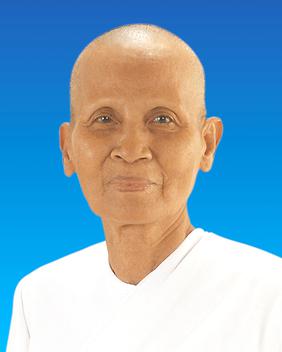
Chandra Khonnokyoong was a Thai Maechi (nun) who founded Wat Phra Dhammakaya. Religious studies scholar Rachelle Scott has described her as "the most influential female meditation teacher in Thailand". Her own students call her Khun Yay Achan Mahā-ratana Upasika Chandra Khonnokyoong, an honorific name meaning "grandmother-master-great-gem devotee". Although illiterate, she was widely respected for her experience in meditation, which is rare for a maechi. She managed to attract many well-educated students, despite her rural background and illiteracy. Some scholars have raised the example of Maechi Chandra to indicate that the position of women in Thai Buddhism may be more complex than was previously thought.
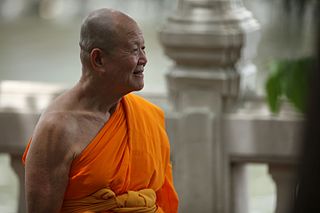
Luang Por Dattajivo, also known by his birth name Phadet Phongsawat and former ecclesiastical title Phrarajbhavanajahn, is a Thai Buddhist monk. He is the former deputy-abbot of Wat Phra Dhammakaya and the vice-president of the Dhammakaya Foundation, and was the observing abbot of the temple from 1999 until 2006, and again from 2011 until 2016. As of December 2016, he was still widely considered the de facto abbot. He met Mae chi (nun) Chandra Khonnokyoong and Luang Por Dhammajayo in his student years, and they have been his teachers throughout his life.
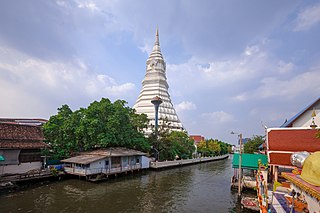
Wat Paknam Bhasicharoen is a royal wat ('temple') located in Phasi Charoen district, Bangkok, at the Chao Phraya River. It is part of the Maha Nikaya fraternity and is the origin of the Dhammakaya tradition. It is a large and popular temple, supported by prosperous community members.
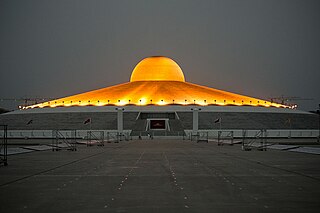
Wat Phra Dhammakaya is a Buddhist temple (wat) in Khlong Luang district, in the Pathum Thani province north of Bangkok, Thailand. It was founded in 1970 by the maechi (nun) Chandra Khonnokyoong and Luang Por Dhammajayo. It is the best-known and the fastest growing temple of the Dhammakaya tradition. This tradition, teaching Dhammakaya meditation, was started by the meditation master Luang Pu Sodh Candasaro in the early 20th century. Wat Phra Dhammakaya is one of the temples that emerged from this tradition and is part of the Mahā Nikāya fraternity. The temple is legally represented by the Dhammakaya Foundation. It aims to adapt traditional Buddhist values in modern society, doing so through modern technology and marketing methods. The temple has faced controversy and a government crackdown. Wat Phra Dhammakaya plays a leading role in Thai Buddhism, with theologian Edward Irons describing it as "the face of modern Thai Buddhism".
Wat Phra Dhammakaya Manchester, also known in English as the North-West Centre for Buddhist Meditation, is a Thai Buddhist temple in Salford, England. Established on 8 February 2004 in a converted curtain-rail factory, it was the first Thai Buddhist temple in the northwest of England.

Wat Pavaranivesh Vihara Ratchawarawihan is a major Buddhist temple (wat) in Phra Nakhon district, Bangkok, Thailand. Being the residence of Nyanasamvara Suvaddhana, the late Supreme Patriarch of Thailand, it is the final resting place of two former kings of Chakri Dynasty: King Vajiravudh and King Bhumibol Adulyadej. The temple was established in 1824 by Mahasakti Pol Sep, viceroy during the reign of King Rama III.

Dhammakaya meditation is a method of Buddhist Meditation developed and taught by the Thai meditation teacher Luang Pu Sodh Candasaro (1885–1959). In Thailand, it is known as Vijjā dhammakāya, which translates as 'knowledge of the dhamma-body'. The Dhammakaya Meditation method is popular in Thailand and other parts of Southeast Asia, and has been described as a revival of samatha (tranquility) meditation in Thailand.
P. A. Payutto, also known by his current monastic title, Somdet Phra Buddhaghosacariya, is a well-known Thai Buddhist monk, an intellectual, and a prolific writer.
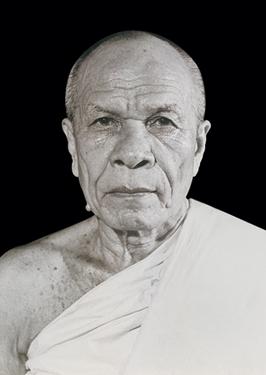
Luang Pu Sodh Candasaro, also known as Phramongkolthepmuni, was a Thai Buddhist monk who served as the abbot of Wat Paknam Bhasicharoen from 1916 until his death in 1959. He founded the Thai Dhammakāya school in the early 20th century. As the former abbot of Wat Paknam Bhasicharoen, he is often called Luang Pu Wat Paknam, meaning 'the Venerable Father of Wat Paknam'. He became a well-known meditation master during the interbellum and the Second World War, and played a significant role in developing Thai Buddhism during that period. He is considered by the Dhammakaya tradition to have rediscovered Vijja Dhammakaya, a meditation method believed to have been used by the Buddha himself. Since the 2000s, some scholars have pointed out that Luang Pu Sodh also played an important role in introducing Theravāda Buddhism in the West, a point previously overlooked.
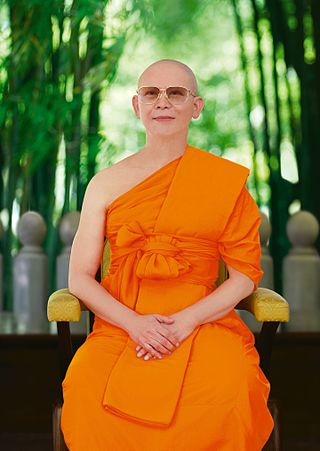
Luang Por Dhammajayo, also known by the lay name Chaiyabun Suddhipol, is a Thai Buddhist monk. He was the abbot of the Buddhist temple Wat Phra Dhammakaya, the post he held until 1999 and again from 2006 to December 2011. In December 2016, he was given the post of honorary abbot of the temple. He is a student of the nun (maechi) Chandra Khonnokyoong, and is the most well-known teacher of Dhammakaya meditation. He has been subject to criticism and government response. However, he continues to be a spiritual leader that has significant influence in Thai society. Luang Por Dhammajayo's approach to Buddhism seeks to combine the ascetic and meditative life with modern personal ethics and social prosperity.
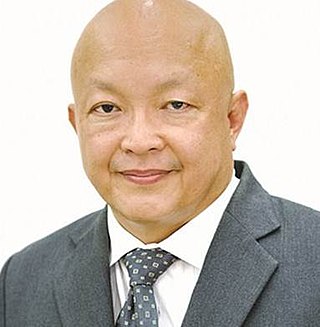
Mano Laohavanich is a Thai politician, former professor of Buddhism at Thammasat University, and former Buddhist monk. He is most famous for his public statements against Wat Phra Dhammakaya, the largest Buddhist temple in Thailand.

Wat Phra Dhammakaya is a Buddhist temple in Thailand. It was founded in 1970 by the maechi (nun) Chandra Khonnokyoong and Luang Por Dhammajayo. The temple's founding has roots in the Dhammakaya tradition founded by Luang Pu Sodh Candasaro at Wat Paknam Bhasicharoen in the early 20th century. Wat Phra Dhammakaya is known for its modern dissemination methods and use of technology.

Somdet Phra Ariyavangsagatayana, born Amborn Prasatthapong, is the current Supreme Patriarch of Thailand and Superior General of the Dhammayut Order. Ordained as a bhikkhu in 1948 with the Dhamma name of Ambaro. In 2008 he was appointed abbot of Wat Ratchabophit in Bangkok. In 2017, he was appointed Supreme Patriarch by King Vajiralongkorn, succeeding Vajirañāṇasaṃvara who died in 2013.

Wat Paknam Japan is the largest Thai Buddhist temple ('Wat') in Japan, located in Narita City, Chiba Prefecture. It was founded in 1998 as a branch temple of Wat Paknam, a temple in Thailand, to serve as a spiritual center for residents of Thai descent.














